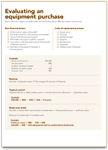Analyze before you add
Will clients embrace your new service? Crunching the numbers and weighing the pros and cons can help you decide.
Adding a new service to your repertoire is a great way to practice better medicine. And any time you do something that benefits the pet, you'll affect the practice's bottom line. Hopefully there will be more money to invest in staff, more money to take home, and more money to invest in equipment. But before you add a service, think about how this care will help your client base.
"Start by quantifying the number of patients," says Dr. Karen Felsted, CPA, MS, CVPM, with Gatto McFerson in Santa Monica, Calif. "How many patients do you see in a week that could really use an ultrasound, for example?"

Consider the financial and non-financial factors before purchasing a new piece of equipment or adding a new service. At vetecon.com youâÂÂll find "Evaluating an Equipment Purchase" posted under the Forms section.
To figure this out, Dr. Felsted says, look at referrals. "If you're referring patients for ultrasounds, look at how many you refer each week or month. You can also pull records for a month and count the number of cases that, in a perfect world, could've used an ultrasound."
All aboard
Once you've decided a new service will benefit clients and patients, you need to determine how committed the other doctors in the practice are to offering it. Do they think that ultrasound is a good tool? Would they use it for all of those "perfect world" cases you identified? "If two doctors are gung-ho and one's lukewarm, it can cut potential cases by one-third," Dr. Felsted says. "Make sure doctors feel committed to learning any new skills they need to provide the service, too. And if one doctor's not willing, you need to talk about whether you'll refer those cases internally."
The next step: Put all of the financial information together into a cashflow analysis and consider whether this service will be profitable for your practice. "How long will it take you to pay for the new equipment?" Dr. Felsted asks. "If it will be four years before you start making money on it, think about where you'll be then. For example, will you need to update the equipment?
"You may end up saying, 'I'm going to add this because I think it's good medicine, it's a toy that I want, and I realize I'm just going to break even.'" And Dr. Felsted says that's not a terrible decision to make, as long as you realize what you're getting into financially.
If you want to improve the potential profitability, Dr. Felsted says, think about what you can do differently: charge more for the service, make a strong effort to educate clients, get all the doctors on-board—or any other step that would generate more cases. Or, you could try to encourage referrals from other practices. This kind of analysis can also help you compare two pieces of equipment and decide the best place to spend your money, she says.
"It's easy to launch into an equipment purchase and think it will automatically be great," says Dr. Felsted. "But when push comes to shove you're not making money. If you had completed a financial analysis in the beginning, that outcome would've been apparent."
In the long run, Dr. Felsted says, if you don't make investments in new services you could hurt your practice. "Medicine and business change over time and you've got to keep up."